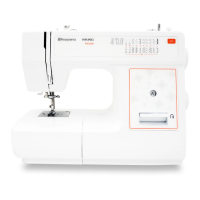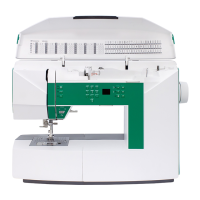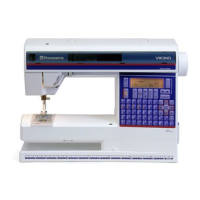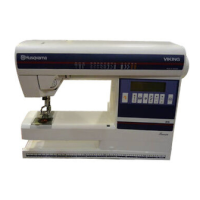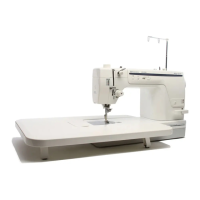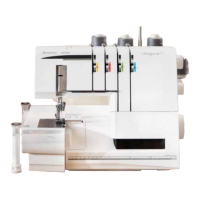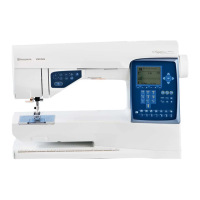
Do you have a question about the Husqvarna Viking Prelude 350 and is the answer not in the manual?
| Type | Mechanical |
|---|---|
| Stitch Options | Utility, Decorative |
| Needle Positions | Variable |
| Stitch Width | 5 mm |
| Presser Feet | Snap-On |
| Maximum Stitch Length | 4 mm |
| Maximum Stitch Width | 5 mm |
| Free Arm | Yes |
| Foot Control | Yes |
| Buttonhole Styles | 1 Step Buttonhole |
Precautions to reduce the risk of electric shock when operating the sewing machine.
Guidelines to prevent burns, fire, electric shock, and injuries during sewing machine use.
Steps for safely removing the sewing machine and its accessories from the packaging.
Instructions for properly storing the sewing machine and its components after sewing.
How to properly connect the foot control to the sewing machine for operation.
Steps for connecting the main power cord and ensuring correct voltage settings.
Using the accessory box for storage and creating an extended work surface.
Step-by-step guide for correctly threading the upper thread through the sewing machine.
Instructions for winding thread onto a bobbin using the sewing machine's winder.
How to wind a bobbin using the vertical spool pin for specialty threads.
Correctly inserting the wound bobbin into the bobbin case for sewing.
How to adjust the thread tension dial for optimal stitch quality.
Identifying correct and incorrect thread tension through sample stitches.
Instructions for replacing the sewing needle and attaching/detaching presser feet.
Adjusting presser foot pressure and using the presser foot lever for sewing different fabrics.
How to use reverse stitch and lower feed teeth for specific sewing tasks.
How to choose and set stitches using the stitch selector dial and guide.
Understanding stitch length and width adjustments for different stitch types.
How to change the stitch width using the stitch width dial for various effects.
Guidelines for setting the stitch length for optimal sewing results.
Using the guide to select the best stitch for woven, stretch, leather, and vinyl fabrics.
Guidance on stitches for seaming, overcasting, basting, blind hemming, and buttonholes.
Understanding the differences between woven and knit fabrics and their properties.
Characteristics of leather and vinyl materials for sewing applications.
How to use the buttonhole foot C for sewing buttonholes of various sizes.
Technique for cording buttonholes in stretch fabrics for added stability.
Step-by-step guide to sewing perfect balanced buttonholes with both columns in the same direction.
Instructions for sewing buttons using the zigzag stitch and creating a thread shank.
Method for safely cutting open sewn buttonholes using a seam ripper.
Using the straight stitch for joining fabrics that do not stretch or require strain resistance.
How to use the clearance plate for sewing over thick seams or uneven fabric layers.
Guidance on using the zipper foot to sew zippers on both sides of a garment.
Step-by-step instructions for sewing a lapped zipper into a garment.
Using the reinforced straight stitch for heavy fabrics and seams under strain.
How to adjust needle positions for edge stitching and narrow hems.
Using the zigzag stitch for lace, edging, and appliqués.
Overcasting edges and mending worn fabric using the three-step zigzag stitch.
Tips for sewing loosely woven terry cloth, including seam finishing.
Using stitches for seaming and overcasting fabric edges to prevent fraying.
How to create an invisible hem using the blind hem stitch and presser foot D.
Using the flatlock stitch for overlapped seams, decorative hems, and gathering.
How to gather fabric or attach ruffles using the gathering foot.
Using the quilter's foot for precise 1/4 inch seams and pivot points.
Using the transparent foot for appliqué, decorative, and taper stitches.
Sewing sticky materials like foam, plastic, and leather with the non-stick glide foot.
Selecting and sewing decorative stitches for embellishment.
Modifying stitches using the guide stitch variation for custom looks.
Instructions for replacing the sewing machine's light bulb.
How to clean lint and debris from the bobbin area and under the stitch plate.
Steps for removing and re-installing the stitch plate for cleaning.
Resolving issues like needle breaks, thread breaks, knots, and incorrect tension.
Troubleshooting fabric puckering, poor feeding, and loose seams.
When to contact a dealer for service and advice on sewing samples.
Information regarding warranty coverage for non-original parts and accessories.


